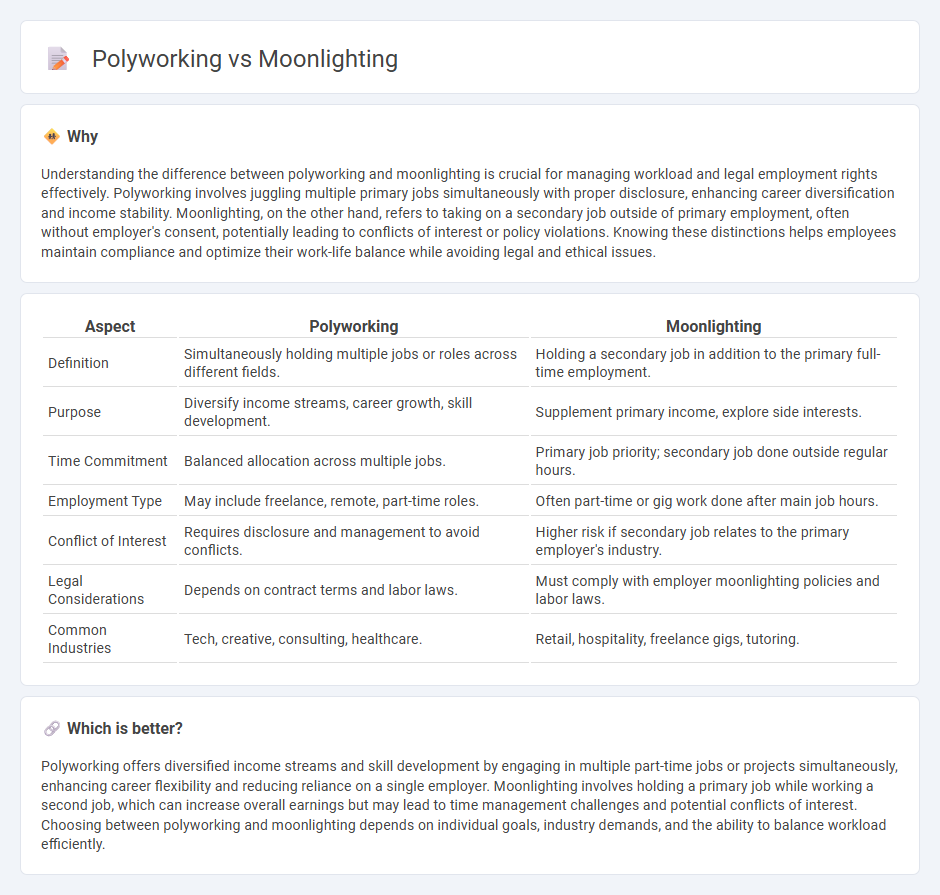
Polyworking involves simultaneously managing multiple jobs or projects across different fields to diversify income and skills, while moonlighting typically refers to taking on a secondary job outside of regular working hours to supplement primary income. Both approaches reflect evolving employment trends as workers seek flexibility, financial stability, and personal growth in a dynamic labor market. Explore how polyworking and moonlighting impact career development and work-life balance.
Why it is important
Understanding the difference between polyworking and moonlighting is crucial for managing workload and legal employment rights effectively. Polyworking involves juggling multiple primary jobs simultaneously with proper disclosure, enhancing career diversification and income stability. Moonlighting, on the other hand, refers to taking on a secondary job outside of primary employment, often without employer's consent, potentially leading to conflicts of interest or policy violations. Knowing these distinctions helps employees maintain compliance and optimize their work-life balance while avoiding legal and ethical issues.
Comparison Table
| Aspect | Polyworking | Moonlighting |
|---|---|---|
| Definition | Simultaneously holding multiple jobs or roles across different fields. | Holding a secondary job in addition to the primary full-time employment. |
| Purpose | Diversify income streams, career growth, skill development. | Supplement primary income, explore side interests. |
| Time Commitment | Balanced allocation across multiple jobs. | Primary job priority; secondary job done outside regular hours. |
| Employment Type | May include freelance, remote, part-time roles. | Often part-time or gig work done after main job hours. |
| Conflict of Interest | Requires disclosure and management to avoid conflicts. | Higher risk if secondary job relates to the primary employer's industry. |
| Legal Considerations | Depends on contract terms and labor laws. | Must comply with employer moonlighting policies and labor laws. |
| Common Industries | Tech, creative, consulting, healthcare. | Retail, hospitality, freelance gigs, tutoring. |
Which is better?
Polyworking offers diversified income streams and skill development by engaging in multiple part-time jobs or projects simultaneously, enhancing career flexibility and reducing reliance on a single employer. Moonlighting involves holding a primary job while working a second job, which can increase overall earnings but may lead to time management challenges and potential conflicts of interest. Choosing between polyworking and moonlighting depends on individual goals, industry demands, and the ability to balance workload efficiently.
Connection
Polyworking and moonlighting both involve engaging in multiple jobs or income streams simultaneously, reflecting a trend towards diversified employment to increase financial stability. Polyworking typically encompasses managing several roles either full-time or part-time across different industries, whereas moonlighting focuses on taking an additional job outside regular working hours. Both practices highlight the evolving labor market dynamics where workers seek flexibility, skill development, and supplementary earnings beyond traditional single-employment models.
Key Terms
Multiple Jobs
Moonlighting involves holding a second job outside of regular working hours, typically to supplement income, while polyworking refers to managing multiple careers or projects simultaneously, often spanning diverse fields and income streams. Moonlighting usually entails a primary full-time job with an additional side job, whereas polyworking encompasses a more integrated and balanced approach to multiple professional roles. Explore the distinctions and benefits of moonlighting and polyworking to optimize your career strategy.
Employment Contracts
Moonlighting typically involves employees taking on a second job outside their primary employment contract, often without explicit permission, which can lead to breaches of exclusivity or conflict-of-interest clauses. Polyworking, however, refers to managing multiple work roles simultaneously across different contracts, each requiring clear terms to delineate rights, responsibilities, and intellectual property ownership to avoid legal disputes. Explore the nuances of how employment contracts address moonlighting versus polyworking to safeguard both employer and employee interests.
Conflict of Interest
Moonlighting often involves taking a second job outside regular employment hours, raising significant concerns about conflicts of interest due to competing company policies or confidentiality breaches. Polyworking, by contrast, typically encompasses managing multiple roles or projects concurrently, demanding clear boundaries to prevent overlap in business interests and intellectual property rights. Explore further to understand how to navigate and mitigate conflict of interest risks effectively in dual or multiple job arrangements.
Source and External Links
MOONLIGHTING definition | Cambridge English Dictionary - Moonlighting is the act of working an extra job, often without informing your primary employer, commonly done to boost income or start a business during tough economic times.
moonlighting | Wex | US Law | LII / Legal Information Institute - Moonlighting refers to working more than one job simultaneously, typically holding a second job outside normal hours, though some employers restrict this due to conflicts or performance concerns.
Moonlighting - Moonlighting can also refer to a side job beyond one's main employment or entertainments such as the 1985-1989 TV series starring Bruce Willis and Cybill Shepherd, or various films and albums sharing the name.
 dowidth.com
dowidth.com